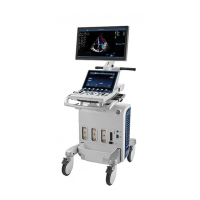Measurements and Analysis
8-98 Vivid S70 / S60 – User Manual
BC092760-1EN
01
Doppler alignment
Errors in velocity measurements increase with the cosine of the
angle between the measured flow and the ultrasound beam. For
example, an alignment error of 20 degrees, will give a 6%
under-estimation of the velocities, while an error of 40 degrees
will cause the under-estimation to be 24%. It is highly
recommended to optimize transducer position to align the
ultrasound beam with the flow direction.
NOTE: If alignment is not possible, you may use the Angle Correction
control to compensate if the flow direction is known.
Screen pixel resolution
The display screen is composed of an array of square picture
elements (pixels). The smallest resolvable unit is +/- 1pixel. This
pixel error is only significant when measuring short distances on
the screen. By observing good scanning practices, the settings
of the field of view should be such that the measured distance is
significant with respect to the full size of the screen. When such
scaling is impossible, the pixel error may come into play. The
pixel error is +/- 0.2% of the full ultrasound area in the User
Screen.
Algorithms
Some formulae used in clinical calculations are based on
assumptions or approximations. For example the volume
calculations from 2D or M mode assume a certain, ‘ideal’ shape
of the heart chamber, while the actual shape can vary quite
much between individuals. Also, formulae taking several “raw”
measurements as inputs are prone to increased errors,
depending on the combination of input variable accuracies. For
example, the Cardiac Output formula from Doppler is sensitive
to errors in the entered Diameter, since this parameter will be
squared in the formula.
Speed of Sound in Tissue
The average speed of sound value of 1540 meters / second is
used for all calculations. Depending on the tissue structures, this
generalization may give errors from 2% (typical) to 5% (much
fatty tissue layers present).

